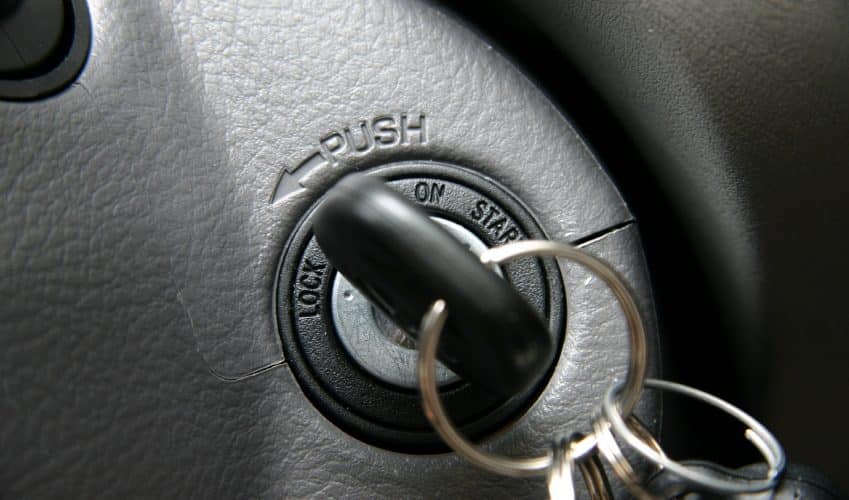On March 10, 2010, Brooke Melton was driving her 2005 Chevrolet Cobalt in Paulding County, Ga., when the car’s engine suddenly shut off. Melton lost control of the vehicle, which veered into oncoming traffic and collided with another car. The crash killed Melton on her 29th birthday.
A General Motors engineer later discovered after downloading the Cobalt’s Sensing Diagnostic Module—the vehicle’s “black box”—that the key in the Cobalt’s ignition had turned from the “run” to the “accessory/off” position just seconds before the crash.
Melton’s parents, Ken and Beth, sued GM in 2011 in a Georgia state court and eventually settled with the automobile manufacturer. However, after GM announced a recall of 2005-2007 Cobalts and Pontiac G5s for an ignition switch defect, the Meltons sued the company again on May 12, 2014. This time, they made much broader accusations.
The Meltons allege GM knew about the ignition defect more than nine years before their daughter’s death, but did nothing to fix the problem or warn consumers. “Rather, GM intentionally, purposely, fraudulently, and systematically concealed the defects,” according to the complaint.
The Meltons’ lawsuit is one of hundreds of actions over the defective ignition switches pending against GM in multidistrict litigation (MDL) proceedings in the U.S. District Court for the Southern District of New York. The MDL court will oversee discovery and rule on pre-trial motions on issues including choice of law and class certification of claims against GM.
Captioned In re: General Motors LLC Ignition Switch Litigation (No. 14-MD-2543; 14-MC-2543), MDL 2543’s official website is www.gmignitionmdl.com.
The MDL court is gearing up to take action in 2015 and has initiated the identification of bellwether cases for trial. Meanwhile, GM has begun assessing claims lodged with the company for compensation and has so far identified 42 death claims eligible for payment.
Master Complaint
On Oct. 14, 2014, the plaintiffs filed a 672-page master class action complaint in the MDL court. At issue are millions of vehicles recalled by GM for the ignition switch defect that were purchased before July 11, 2009.
But the automobile manufacturer’s liability goes far beyond the damage caused by the defective ignition switches, the plaintiffs maintain. In the first eight months of 2014, GM announced 60 recalls unrelated to the ignition switch problem, bringing the total number of recalled vehicles to 27 million, the plaintiffs point out. “The unprecedented scope of these recalls has completely belied [GM’s] claims that they made reliable and safe cars,” they say.
The company, founded in 1908 in Flint, Mich., and now headquartered in Detroit, possessed “the knowledge, the choice, the opportunity, and the responsibility” to prevent personal and economic harm by timely and properly recalling the defective vehicles and correcting the defects, according to the complaint.
Also named in the class action complaint were auto parts manufacturers Delphi Automotive Systems LLC, Delphi Automotive PLC and Delphi Automotive LLC. The plaintiffs voluntarily dismissed the Delphi defendants on Nov. 7.
Complicating an already complex case even further, the defective vehicles were sold by the company before it filed for bankruptcy in the U.S. Bankruptcy Court for the Southern District of New York back in 2009 (the pre-bankruptcy company is known as “Old GM”). The reorganized company that emerged from bankruptcy a few weeks later (known as “New GM”) recalled the vehicles at issue.
The plaintiffs maintain in the complaint that the ignition switches failed before and after the bankruptcy proceedings and both Old and New GM concealed the truth about the defect. They also argue that New GM assumed the liabilities of Old GM related to the conduct at issue.
The parties are currently debating how rulings from the Bankruptcy Court will impact issues being litigated in the MDL.
The Recalls
The complaint states that New GM announced the following recalls of more than 12 million vehicles in 2014:
- February and March. The recall of 2.19 million vehicles, including: 2005-2009 Cobalts; 2007-2009 Pontiac G5s; 2006-2009 Chevrolet HHRs and Pontiac Solstices; 2005-2006 Pontiac Pursuits; 2003-2007 Saturn Ions; and 2007-2009 Saturn Skys;
- June. Another 3.14 million vehicles were recalled. New GM specified that the recalled vehicles had an ignition key designed with a slot rather than a hole. According to NHTSA, 2,349,095 of the vehicles were made by Old GM and sold by New GM. Recalled vehicles with the ignition key slot defect include the: 2005-2009 Buick Lacrosse; 2006-2009 Buick Lucerne; 2004-2005 Buick Regal LS & GS; 2000-2005 Cadillac Deville; 2007-2009 Cadillac DTS; 2006-2009 Chevrolet Impala; and 2006-2007 Chevrolet Monte Carlo.
Here’s another twist for anyone keeping track. According to the plaintiffs, New GM says this ignition key slot defect is different than the ignition switch defect in the February and March recall. But the defects are indistinguishable and pose the same safety risks, the plaintiffs argue.
- July. New GM announced the recall of 7.29 million vehicles due to “unintended key rotation.” The Old GM-made vehicles subject to the recall include the 2000-2005 Chevrolet Impalas and Monte Carlos; 1997-2005 Chevrolet Malibus; 1999-2004 Oldsmobile Aleros; 1999-2005 Pontiac Grand Ams and 2004-2008 Pontiac Grand Prixs; certain 2003-2009 Cadillac CTSs; and certain 2004-2006 Cadillac SRX vehicles.
The plaintiffs allege that the vehicles with the unintended key rotation defect contained defective ignition switches.
- September. New GM announced the recall of nearly 47,000 vehicles due to concerns related to unintended ignition key rotation defects, including 2008-2009 Pontiac G8s, according to the complaint.
To make matters worse, the recall remedies don’t even adequately fix the defect, the plaintiffs argue.
New GM is replacing the ignition switch in the recalled vehicles, which doesn’t address the safety risks involved, they say. Replacing the ignition switch does not address the problem posed by the low positioning of the ignition on the vehicle’s steering cylinder. Therefore, the ignition key and switch continue to be prone to inadvertently moving from “run” to “accessory,” the plaintiffs claim. “Even with New GM’s alleged ‘fix,’ drivers of ordinary height can hit the ignition key with their knees during ordinary driving situations,” they argue.
Further, New GM’s inadequate remedy “puts the burden on drivers to alter their behavior and carry their ignition keys separately from their other keys, and even from their remote fob,” say the plaintiffs.
MDL 2543 Established
The Meltons’ lawsuit is just one of many filed around the country against New GM.
After some debate about where to centralize and consolidate the ignition switch defect litigation, the U.S. Judicial Panel on Multidistrict Litigation transferred personal injury, wrongful death and economic loss actions filed by plaintiffs in six District Courts to the U.S. District Court for the Southern District of New York. The Southern District of New York is also the site of the GM bankruptcy proceedings, the panel noted in its June 9, 2014 transfer order.
Judge Jesse M. Furman, who heard appeals related to Old GM’s bankruptcy, is overseeing the MDL proceedings.
The proposed nationwide class claims allege breach of implied warranty of merchant ability, fraudulent concealment, unjust enrichment, and violations of the Magnuson-Moss Warranty Act, the federal law that governs consumer product warranties.
The complaint also proposes the certification of classes for each of the 50 states, the District of Columbia and Puerto Rico. The plaintiffs allege state-law claims including deceptive or unfair trade practices.
New GM could face serious financial penalties. The class action complaint seeks actual, compensatory and/or statutory damages; punitive and exemplary damages in an amount sufficient to punish New GM for its alleged misconduct; attorneys’ fees, costs, and pre-judgment and post-judgment interest; and restitution and/or disgorgement of New GM’s alleged unjust enrichment.
Bellwether Selection
The whole point of an MDL is to coordinate and consolidate pretrial proceedings to save time, effort and litigation costs. Bellwether trials, or test trials, are among the case management tools used in multidistrict proceedings. Cases selected for bellwether trials are intended to be a representative sampling of all those in the MDL.
In a Nov. 19, 2014 order, Judge Furman laid out a bellwether trial plan for 2015 and early 2016. The process will start with the identification of 18 personal injury and wrongful death cases for initial discovery, with a subset of those cases chosen for additional pretrial discovery. At the moment, bellwether trials are expected to start in January 2016.
To be eligible for the initial discovery, an action must satisfy several criteria, including that the plaintiff has not already accepted a settlement offer from New GM through its Ignition Compensation Claims Resolution Facility, the order states.
Plaintiffs’ lead counsel and GM’s counsel have until Feb. 17, 2015, to each submit a list of nine eligible plaintiffs. Over the next several months, the parties’ counsel will whittle down the eligible plaintiffs until six actions—three from each side’s list—remain. Those six actions will then proceed to case-specific expert discovery, the order says.
Claims Resolution Facility
For plaintiffs that opt to settle their claims instead of being included in the MDL, the company set up the GM Ignition Compensation Claims Resolution Facility (www.gmignitioncompensation.com), which is administrated by attorney Kenneth R. Feinberg. On Nov. 17, the administrator announced on the website that the deadline for submitting claims to the facility was extended from Dec. 31 to Jan. 31, 2015.
The three categories of eligible claims are individual death claims, individual claims involving the most serious physical injuries such as permanent brain damage and injuries resulting in quadriplegia and paraplegia, and less serious physical injuries, according to the website.
According to a Dec. 12 report on the website, 2,326 claims have been filed with the facility so far, with 100 deemed eligible for compensation, 306 ineligible, 568 deficient, 445 under review, and 907 claims received with no documentation. Of the 251 death claims filed, 42 are considered eligible for payment. Of the 156 claims for serious physical injuries, seven are considered eligible for payment, and of the 1,919 claims filed for less serious physical injuries, 100 are considered eligible for payment, according to the report.
The Facility states on its website that no aggregate cap on claim payouts exists. “GM has agreed to pay whatever the Administrator deems appropriate in each and every individual case,” the website says.
Drivers’ contributory negligence will not be factored into the claims resolution process. Contributory negligence attributed to the driver of the vehicle such as intoxication or speeding, “is irrelevant; the new Program will not examine or evaluate any such contributory negligence,” the website adds.


